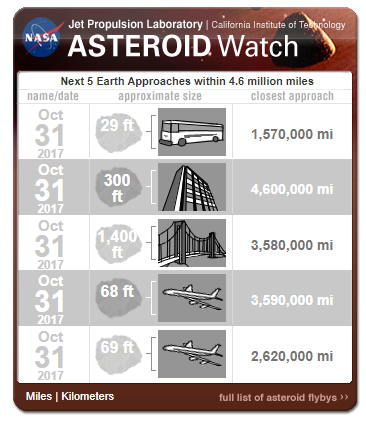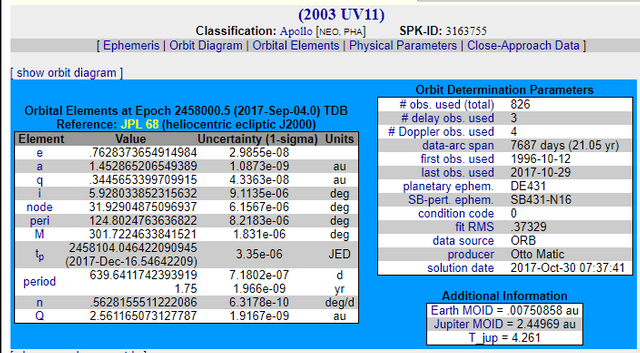Double 'Extinction Level Event' Near Earth Objects for Halloween
What would happen if things shifted by just a few million space miles

Average distance between Earth and the moon is about 239,000 miles (385,000 kilometers).
Source: https://www.jpl.nasa.gov/asteroidwatch/
- 2017 UO43 2017-Oct-31 at a distance of 0.01691 AU and approximate size 6.9 m - 15 m
- 2017 TZ4 2017-Oct-31 at a distance of 0.04951 AU and approximate size 72 m - 160 m
- 2003 UV11 2017-Oct-31 at a distance of 0.03847 AU and approximate size 330 m - 750 m
- 2017 UP6 2017-Oct-31 at a distance of 0.03862 AU and approximate size 16 m - 37 m
- 2017 UO2 2017-Oct-31 at a distance of 0.02822 AU and approximate size 17 m - 37 m
Close Approach Database
Source: https://cneos.jpl.nasa.gov/ca/
Today's Next Five Earth Approaches is filled up for today. While none of these Near Earth Objects (NEOs) will come close to hitting Earth, this time, it is a good time to stop and wonder what is being tracked.
The largest of the NEOs listed is 2003 UV11. The first thing you should notice about NEOs listed in the Close Approach Database is the name. If it starts with a year, that usually means the date that it first started to be tracked. This date may not be the first date it was observed. In the case of 2003 UV11, it was first observed in 1996.

Observations, for the most part are done by telescope, which means someone had to decided to look at a point in the sky and see if anything was moving. Of course, there are thousands and thousands of professional and amateur astronomers looking up to the sky. As technology has improved, so have the telescopes and what they can see, that means it is easier to setup up automated telescopes and computers to spot things roaming in and out of our solar system.
However, as you will note, the other 4 NEOs listed were all spotted this year, within the last 30 days. But, they probably wouldn't do any real damage, unless you were directly underneath them when they blew up on entry.
Asteroid Fast Facts
Size and Frequency
Every day, Earth is bombarded with more than 100 tons of dust and sand-sized particles.
About once a year, an automobile-sized asteroid hits Earth's atmosphere, creates an impressive fireball, and burns up before reaching the surface.
Every 2,000 years or so, a meteoroid the size of a football field hits Earth and causes significant damage to the area.
Finally, only once every few million years, an object large enough to threaten Earth's civilization comes along. Impact craters on Earth, the moon and other planetary bodies are evidence of these occurrences.
Space rocks smaller than about 25 meters (about 82 feet) will most likely burn up as they enter the Earth's atmosphere and cause little or no damage.
If a rocky meteoroid larger than 25 meters but smaller than one kilometer ( a little more than 1/2 mile) were to hit Earth, it would likely cause local damage to the impact area.
We believe anything larger than one to two kilometers (one kilometer is a little more than one-half mile) could have worldwide effects. At 5.4 kilometers in diameter, the largest known potentially hazardous asteroid is Toutatis.
By comparison, asteroids that populate the main asteroid belt between Mars and Jupiter, and pose no threat to Earth, can be as big as 940 kilometers (about 583 miles) across. ~ https://www.jpl.nasa.gov/asteroidwatch/fastfacts.php
Basically, there are a lot of asteroids in the belt between Mars and Jupiter that could cause an Extinction Level Event if they were knocked out of the belt and into the path of the Earth. From the FAQ, you will notice that asteroid Toatatis has a name. The really big reoccurring asteroids get names. Those are the ones to keep an eye on, but their orbits have plenty of data tracking points, so they know where they are going. There is also a chance that something is floating around in the Oort Cloud heading our way that they haven't started tracking yet.
NASA claims
With over 90% of the near-Earth objects larger than one kilometer already discovered
That means there is still that 10% that they haven't found that are just lurking out in space waiting to do a flyby on Earth. And, if there is Hypothetical 'Planet X' floating out in our Solar System knocking things around, then there might be more than 10% unknown NEOs.
A potentially hazardous object (PHO) is a near-Earth asteroid or comet with an orbit such that it has the potential to make close approaches to the Earth and is of a size large enough to cause significant regional damage in the event of impact. A potentially hazardous object can be known not to be a threat to Earth for the next 100 years or more, if its orbit is reasonably well determined. ~ https://en.wikipedia.org/wiki/Potentially_hazardous_object
Here is the link to the TXT version. There are just over 1800 listed.
Trick or Treat? Today's article was a Trick on this Halloween.



The ones that really concern me are those that do not appear in NASA's NEOs lists. Let's hope they find planet X fast. So we can follow its orbit and see if it sends us objects from the Oort cloud.
Seriously.
10% might not seem like a lot, but I need to find out how many are in the 90% range.
Found it.
There are 1837 known Potentially Hazardous Asteroids.
That means there are at least 183 that they haven't found.
So, since March of THIS year, they added 51 to the list.
It's the things you don't know that finally get ya! 🐓
I hate bots too!!!!!!
The unknown unknowns.
I kept reading NEO and had to keep reminding myself it meant Near Earth Object and not NEO as in the cryptocurrency ><. Great update on NEO's as usual. Maybe you could throw me really off one day and write about NEO the cryptocurrency. Then my head would be really spinning.
I'll have to remember that for April 1st. ;)
Ha! Same... except for I was reading it as Neo from The Matrix :O